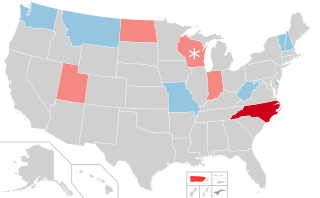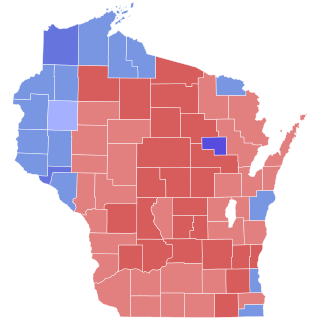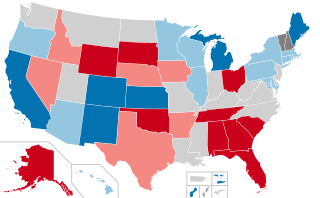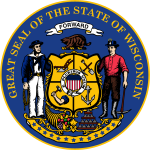
The governor of Wisconsin is the head of government of Wisconsin and the commander-in-chief of the state's army and air forces. The governor has a duty to enforce state laws, and the power to either approve or veto bills passed by the Wisconsin Legislature, to convene the legislature, and to grant pardons, except in cases of treason and impeachment. The position was first filled by Nelson Dewey on June 7, 1848, the year Wisconsin became a state. Prior to statehood, there were four governors of Wisconsin Territory.

Patrick Joseph Lucey was an American politician. A member of the Democratic Party, he served as the 38th Governor of Wisconsin from 1971 to 1977. He was also independent presidential candidate John B. Anderson's running mate in the 1980 presidential election.

The lieutenant governor of Illinois is the second highest executive of the State of Illinois. In Illinois, the lieutenant governor and governor run on a joint ticket and are directly elected by popular vote. Gubernatorial candidates select their running mates when filing for office and appear on the primary election ballot together. When the governor of Illinois becomes unable to discharge the duties of that office, the lieutenant governor becomes acting governor. If the governor dies, resigns or is removed from office, the lieutenant governor becomes governor. Under the Illinois Constitution, the Attorney General is next in line of succession to the Governor's office after the lieutenant governor, but does not succeed to the lieutenant governor's office. From the impeachment of Rod Blagojevich in 2009, until the inauguration of Sheila Simon in 2011, Attorney General Lisa Madigan would have become governor if Pat Quinn had vacated the office. Historically, the lieutenant governor has been from either the Democratic Party or Republican Party. The current lieutenant governor is Democrat Juliana Stratton.

United States gubernatorial elections were held on November 5, 2002, in 36 states and two territories. The Republicans won eight seats previously held by the Democrats, as well as the seat previously held by Minnesota governor Jesse Ventura, who was elected on the Reform Party ticket but had since renounced his party affiliation. The Democrats won 10 seats previously held by the Republicans, as well as the seat previously held by Maine governor Angus King, an independent. The elections were held concurrently with the other United States elections of 2002.

Wisconsin gubernatorial elections are held on the first Tuesday after the first Monday of November every four years on even, non-presidential election years since 1970. Between 1884 and 1970, gubernatorial elections were held on every even-numbered year. Prior to 1882, gubernatorial elections were held on every odd-numbered year.

The 1970 New York gubernatorial election was held on November 3, 1970 to elect the governor and lieutenant governor of New York. Incumbent Republican Governor Nelson Rockefeller defeated the Democratic nominee, former UN Ambassador and U.S. Supreme Court Justice Arthur Goldberg, by more than ten percentage points. On January 1, 1971, Rockefeller was sworn in for his fourth term as governor. Rockefeller received over 3.15 million votes in total, the highest total in any New York gubernatorial election until Andrew Cuomo received 3.64 million in 2018.

United States gubernatorial elections were held in 12 states and two territories. Of the eight Democratic and four Republican seats contested, only that of North Carolina changed party hands, giving the Republicans a net gain of one governorship. These elections coincided with the presidential election on November 6, 2012. As of 2024, this marked the last time in which a Democrat won the governorship in Missouri and the last time in which a Republican won the governorship in North Carolina.

The 1970 Hawaii gubernatorial election was Hawaii's fourth gubernatorial election. The election was held on November 3, 1970, and resulted in a victory for the Democratic candidate, incumbent Governor of Hawaii John A. Burns over Republican candidate, Judge Samuel Pailthorpe King. Burns received more votes than King in every county in the state.

The 1976 Illinois gubernatorial election was held in Illinois on November 2, 1976. Incumbent first-term Democratic governor Dan Walker lost renomination to Illinois Secretary of State Michael Howlett, who was an ally of Chicago mayor Richard J. Daley. Howlett then lost the general election to Republican nominee James R. Thompson. This election was the first of seven consecutive Republican gubernatorial victories in Illinois, a streak not broken until the election of Democrat Rod Blagojevich in 2002.

The 1972 Illinois gubernatorial election was held in Illinois on November 7, 1972. Incumbent first-term Republican governor Richard B. Ogilvie lost reelection in an upset to the Democratic nominee, Dan Walker.

The 1986 Wisconsin gubernatorial election was held on November 4, 1986. Republican Tommy Thompson won the election with 53% of the vote, winning his first term as Governor of Wisconsin and defeating incumbent Governor Anthony Earl. This was the first time since 1962 that the winner of a Wisconsin gubernatorial election was of the same party as the incumbent president. Jonathan B. Barry unsuccessfully sought the Republican nomination.

The 1978 Wisconsin gubernatorial election was held on November 7, 1978. Republican Lee S. Dreyfus won the election with 54% of the vote, winning his first term as Governor of Wisconsin and defeating incumbent Democrat Martin J. Schreiber. Bob Kasten unsuccessfully sought the Republican nomination.

The 1968 Wisconsin gubernatorial election was held on November 5, 1968. Republican Warren P. Knowles won the election with 53% of the vote, winning his third term as Governor of Wisconsin and defeating Democrat Bronson La Follette. This was the last gubernatorial election in Wisconsin where the governor was elected to a two year term separately from the Lieutenant Governor.

The 1962 Wisconsin gubernatorial election was held on November 6, 1962. Democrat John W. Reynolds won the election with 51% of the vote, winning his first term as Governor of Wisconsin and narrowly defeating Republican Philip Kuehn. As of 2022, this was the last time Menominee County voted for the Republican candidate. Until 2022, this was the last gubernatorial election where a Democratic governor was elected during the tenure of a Democratic president.

United States gubernatorial elections were held on November 8, 2022, in 36 states and three territories. As most governors serve four-year terms, the last regular gubernatorial elections for all but two of the seats took place in the 2018 U.S. gubernatorial elections. The gubernatorial elections took place concurrently with several other federal, state, and local elections, as part of the 2022 midterm elections.

The 1916 Wisconsin gubernatorial election was held on November 7, 1916.

The 1863 Wisconsin gubernatorial election was held on November 3, 1863. Republican Party candidate James T. Lewis won the election with nearly 60% of the vote, defeating Democratic candidate Henry L. Palmer.

The 2022 Wisconsin gubernatorial election was held on November 8, 2022, to elect the governor of Wisconsin. Incumbent Democratic governor Tony Evers won re-election to a second term by a margin of 3.4%, defeating Republican nominee Tim Michels.

United States gubernatorial elections are scheduled to be held on November 3, 2026, in 36 states and three territories. The previous gubernatorial elections for this group of states took place in 2022, except in New Hampshire and Vermont, where governors serve two-year terms and will elect their governors in 2024. Many but some elections have an incumbent who is officially term-limited.

The 1968 Wisconsin lieutenant gubernatorial election was held on November 5, 1968. Republican Jack B. Olson won the election with 59% of the vote, winning his fourth term as Lieutenant Governor of Wisconsin and defeating Democrat Taylor Benson. This was the last lieutenant gubernatorial election in Wisconsin where the lieutenant governor was elected to a two-year term separately from the Governor, when a constitutional amendment which made it so the two offices were elected on a single ticket for four years. As part of the amendment, the Lieutenant governor would be elected separately from the governor in primary elections.























